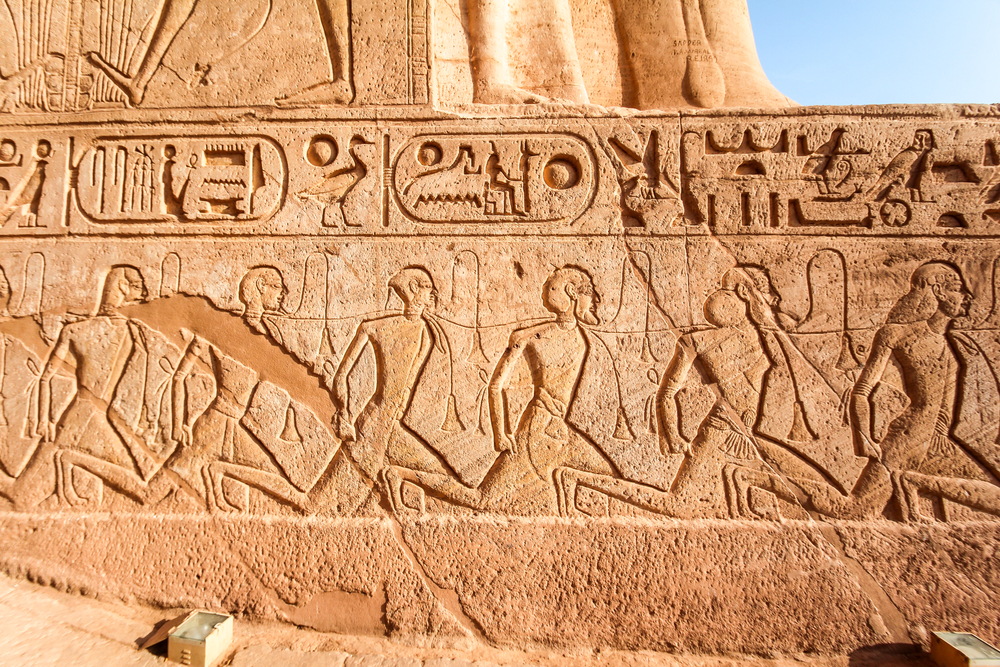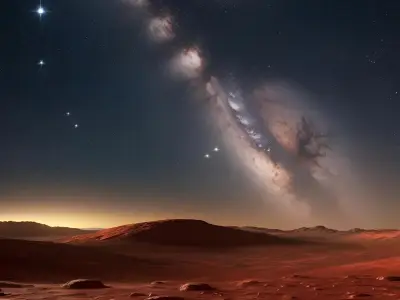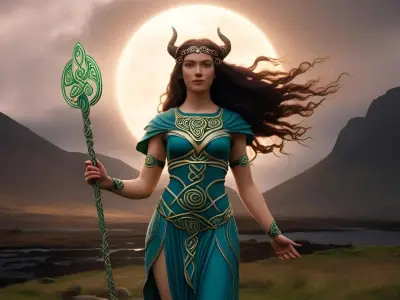Among the Egyptian gods and goddesses, Sobek stands out with his crocodile head and the fierce power he represents. This blog post explores Sobek's myths, legends, and powers, giving you deeper insights into the fascinating lives of ancient Egyptians.
Jump to:
- Who is Sobek?
- Sobek’s Role in Ancient Egyptian Religion
- Sobek’s Temples and Worship
- Myths and Legends of Sobek
- Sobek's Family Tree and Relationships
- Powers and Symbols of Sobek
- Sobek in Popular Culture and Modern References
- Fun Facts About Sobek
- Frequently Asked Questions About Sobek
- Study Egyptian Mythology for £29
Who is Sobek?
Sobek, also known as Sebek, Sochet, and Suchos, is one of the most intriguing gods in Egyptian mythology. He is often depicted as a man with the head of a crocodile, or simply as a crocodile. Sobek is the god of the Nile, fertility, and military prowess, and he plays a significant role in both the natural and supernatural worlds of ancient Egypt.
Recommended for you!
Best SellersWhat does the name Sobek mean?
The name Sobek is derived from ancient Egyptian, and while its exact meaning is debated, it is often associated with the crocodile. Sobek embodies the strength and unpredictability of these powerful creatures.
Sobek’s Role in Ancient Egyptian Religion

Sobek was known primarily in regions with close ties to water bodies, especially the Nile River. The Nile was the lifeblood of ancient Egypt, and as the god associated with it, Sobek was deeply worshipped. He was believed to control the waters, ensuring fertile lands and abundant harvests. Sobek’s connection to the Nile also linked him to life, death, and rebirth, central themes in Egyptian mythology.
Sobek’s Temples and Worship
Sobek was worshipped in various temples across Egypt, with the most famous ones located in Crocodilopolis (modern-day Faiyum) and Kom Ombo. These temples housed live crocodiles, believed to be the living incarnations of Sobek, and were treated with great respect. Priests would adorn these sacred crocodiles with jewellery and feed them special foods, signifying the deep respect and fear Sobek commanded.
Myths and Legends of Sobek
Sobek’s stories are a big influence on the Egyptian worldview, highlighting his dual nature as both a creator and a protector. These myths highlight Sobek’s divine power and illustrate the essential role he played in the lives and spiritual beliefs of the Egyptian people. Here are three of Sobek’s most popular myths:
Sobek’s Creation Myth
According to some myths, Sobek emerged from the primordial waters of chaos, representing the first land to appear from the watery abyss. This myth highlights Sobek’s connection to creation and his role as a god who brings order from chaos.
The ancient Egyptians believed that before the world was formed, there was only a vast, dark, and chaotic expanse of water. From this chaos, Sobek arose, symbolising the emergence of land and stability. This act of creation associated Sobek with the concept of maat, the fundamental order and balance of the universe, a key principle to Egyptian cosmology.
Sobek and the Nile Floods
One of the key legends associated with Sobek is his control over the annual flooding of the Nile. These floods were crucial for agriculture, as they deposited rich, fertile silt onto the land, replenishing the soil and ensuring bountiful harvests. Sobek’s ability to command these waters highlighted his importance in ensuring the survival and prosperity of the Egyptian people.
The annual inundation was both a time of renewal and a reminder of Sobek’s power. It was believed that Sobek’s presence in the Nile made the river’s waters fertile and life-giving, directly linking him to the sustenance and wellbeing of the entire nation.
Sobek in the Afterlife
Sobek also played a role in the afterlife, a key component of Egyptian religious belief. He was believed to protect the dead and guide them safely to the afterlife. This protective aspect of Sobek highlights his dual nature: fierce and fearsome yet also a guardian and protector.
In the journey through the Duat, the Egyptian underworld, Sobek’s presence was a source of comfort to the deceased, ensuring that they were safeguarded from malevolent forces and led towards Osiris, the god of the afterlife. Sobek’s role in the afterlife emphasised his importance in the spiritual realm, where he continued to exert his protective and guiding influence.
Sobek's Family Tree and Relationships
Sobek had various connections and relationships with other gods and goddesses, which placed him within the broader context of the Egyptian pantheon.
- Neith: In some traditions, Sobek is considered the son of Neith, the goddess of war and weaving. This connection to Neith, a powerful and ancient deity, adds to Sobek’s own stature within the pantheon.
- Set: In certain myths, Sobek is associated with Set, the god of chaos, storms, and violence, highlighting Sobek’s dual nature of creation and destruction.
- Renenutet: Sobek was frequently associated with Renenutet, the cobra goddess linked to fertility and harvest. She was sometimes considered his wife, symbolising a union that combined the powers of water and land fertility.
- Osiris: Sobek assists in the resurrection of Osiris by gathering his body parts from the Nile. This act underscores Sobek’s role in regeneration and protection.
- Ra: Sobek is sometimes associated with Ra, the sun god, and is depicted as a protector of Ra during his nightly journey through the underworld, showcasing Sobek’s protective attributes.
- Hathor: In some myths, Sobek is connected with Hathor, the goddess of love, beauty, and motherhood, highlighting Sobek’s role in fertility and life-giving aspects.
Powers and Symbols of Sobek

Sobek is one of the most powerful and complex gods in Egyptian mythology. His powers and symbols reveal much about his nature and the respect he commanded among the ancient Egyptians.
Sobek’s Powers
- Strength and Military Prowess: Sobek was often invoked by soldiers seeking courage and victory in battle. He symbolises might and bravery, making him a powerful ally in warfare. The ancient Egyptians saw Sobek as a protector who could ensure their safety and success on the battlefield.
- Fertility: Sobek played a role in ensuring the fertility of the land and the people. His association with the Nile, the lifeblood of Egypt, highlights his control over the waters essential for agriculture. The Nile’s annual flooding, which deposited nutrient-rich silt onto the land, was believed to be under Sobek’s control.
Symbols Associated with Sobek
- Crocodile: Sobek is commonly associated with the crocodile, a creature both feared and worshipped in ancient Egypt. His depictions often include a crocodile's head or a full crocodile body.
- Water, particularly the Nile: Sobek’s connection to the Nile signifies his importance in ensuring the fertility and prosperity of the land.
- Ankh: The ankh, representing life, is another symbol linked to Sobek, highlighting his role in creation and sustaining life.
Sobek in Popular Culture and Modern References
Sobek’s influence extends beyond ancient Egypt into modern culture. He appears in various books, films, and games, often symbolising raw power and ancient mystery. Sobek’s enduring presence in popular culture demonstrates the lasting fascination with his mythos and the ancient Egyptian pantheon.
Fun Facts About Sobek

- Sobek’s Sacred Crocodiles: In ancient Egypt, sacred crocodiles were kept in temples and treated with great care. These crocodiles were believed to be earthly manifestations of Sobek.
- Healing Powers: Sobek was sometimes considered a god of healing, with the belief that his waters could cure ailments and bring rejuvenation.
- Hybrid Representations: In some depictions, Sobek is shown with the body of a lion, symbolising his connection to strength and power.
Recommended for you!
Best SellersFrequently Asked Questions About Sobek
Who is Sobek in the Bible?
Sobek does not appear in the Bible. He is an ancient Egyptian god, and his mythology is separate from that of religious texts and figures found in the Bible.
What is Sobek wearing on his head?
Sobek is often depicted wearing a headdress featuring the sun disc and a pair of upright feathers, sometimes with horns. This headdress signifies his divine status and his connection to the sun god Ra.
Did Sobek create the universe?
While Sobek is not typically credited with creating the universe, he is associated with the creation myth, in which he emerges from the primordial waters of chaos, symbolising the emergence of land from the waters and the establishment of order.
Was Sobek good or bad?
Sobek cannot be classified as simply good or bad. Like many deities in Egyptian mythology, he embodies both protective and fearsome aspects. He is a guardian and a bringer of fertility, but also a symbol of the dangers and unpredictability of the Nile and the wilderness.
Why did Sobek eat Osiris?
In some versions of the myth, Sobek is said to have eaten Osiris' body parts after Set murdered him. This act symbolises the cycle of life and death, as Sobek later helps to restore Osiris. It highlights Sobek’s complex role in both destruction and regeneration.
Is Sobek male or female?
Sobek is traditionally depicted as male. He is shown as a man with a crocodile head or as a full crocodile, embodying masculine attributes of strength and dominance.
Did Sobek have a wife?
Sobek was often associated with the goddess Renenutet, who is sometimes considered his wife. Renenutet is a cobra goddess linked to fertility and harvest, complementing Sobek's associations with water and fertility.
What is Sobek’s weakness?
As a god, Sobek does not have typical weaknesses. However, in myths and religious texts, gods can be influenced by other deities and cosmic forces. Sobek's role as both protector and potential threat reflects the complex nature of divine power in Egyptian mythology.
Are Sobek and Anubis brothers?
Sobek and Anubis are not typically described as brothers in Egyptian mythology. They have distinct roles, with Anubis primarily associated with embalming and the afterlife, while Sobek is linked to water, fertility, and protection.
Is Sobek a demon?
Sobek is not a demon. He is a god with both protective and fearsome aspects. The crocodile's ferocity is part of his nature, but he is also a vital deity who brings fertility and protection.
Study Egyptian Mythology for £29
If you're fascinated by Sobek and the rich world of Egyptian mythology, why not delve deeper? Centre of Excellence offers an engaging Egyptian Mythology Diploma Course that explores the myths, legends, and gods of ancient Egypt. For a limited time, you can enrol for just £29.













